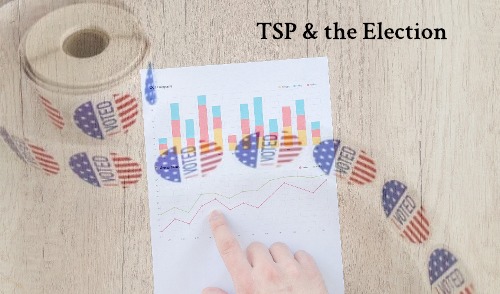STWS Advisor Jennifer Meyer Breaks Down What Feds Need to Know About their TSP Investments on the Brink of a Presidential Election

It is an almost daily question in the life of a financial advisor these days- “should I make any changes to my investments with the election coming up?” The answer to this always depends on individual circumstances and goals, but it is worth taking a look at the historical record of markets in election years to gain some perspective.
Do elections predict market performance or does market performance predict elections? The only thing we know for sure in answering this question is that markets dislike uncertainty. Therefore, it makes sense in the months leading up to an election that there would be volatility. Investors playing the age-old game of trying to time the market, either because they are feeling positive about the future or because they are feeling negative, create the ultimate game of chicken. Contrary to this market timing strategy, historical data shows that staying invested in the correct asset allocation pays off for most long-term investors versus trying to correctly guess the perfect time to get out, as well as the perfect time to get back in.
Let’s look at some data:
1. Since 1928, the performance of the S&P 500 in the 3 months leading up to an election has correctly predicted the outcome 87% of the time. When the S&P 500 has been positive over those three months, the incumbent has won. When it has been negative, the opposing party has won. This is regardless of which party is incumbent. This statistic is true for every election since 1984. (Forbes, August 18, 2020)
2. Since 1928, the market has posted gains in 17 of 23 election years, or 74% of the time. Most of the other 6 times have reasonable explanations for the decline. In 1932 the country was in the midst of the great depression; in 1940 the U.S was on the verge of WWII; in 2000 the tech bubble burst, and 2008 was the financial crisis. Is it possible that this could be one of those years with the COVID pandemic in play? It could be, but given the market rally from March-August, no one knows with certainty what the last four months of 2020 will bring to the markets.
Federal employees have a retirement plan that is based on 2 defined benefit programs; their FERS or CSRS pension and Social Security, and one defined contribution plan, known as Thrift Savings Plan (TSP). This combination is often referred to as the “3-legged stool” for retirement. Pensions and Social Security are determined by formulas that most employees have little control over. However, the TSP for the most part is under the control of employees. An employee decides how much to contribute and how to allocate their funds. Generally, employees are left to their own devices to select how much of their contributions will be allocated to less risky versus more risky investments. How to allocate your TSP should be based on your individual time horizon (when do you think you will start taking money out of TSP?) and tolerance for market volatility. Data shows that staying invested during periods of market volatility will result in better long-term performance than jumping in and out of the market in an attempt to time the ups and downs. Keep this in mind over the next few months during periods of volatility. When feeling uncertain, take comfort in the knowledge that the short-term volatility of election years is generally not a long-term indicator of investment success.
As always, the advisors at Serving Those Who Serve are here to answer your questions regarding your federal benefits.
**Written by Jennifer Meyer, Financial Planner. The information has been obtained from sources considered reliable but we do not guarantee that the foregoing material is accurate or complete. Any opinions are those of Jennifer Meyer and not necessarily those of RJFS or Raymond James. Any information is not a complete summary or statement of all available data necessary for making an investment decision and does not constitute a recommendation. Investing involves risk and you may incur a profit or loss regardless of strategy suggested. Every investor’s situation is unique and you should consider your investment goals, risk tolerance, and time horizon before making any investment or financial decision. Prior to making an investment decision, please consult with your financial advisor about your individual situation. While we are familiar with the tax provisions of the issues presented herein, as Financial Advisors of RJFS, we are not qualified to render advice on tax or legal matters. You should discuss tax or legal matters with the appropriate professional.**

The Election and Your TSP
